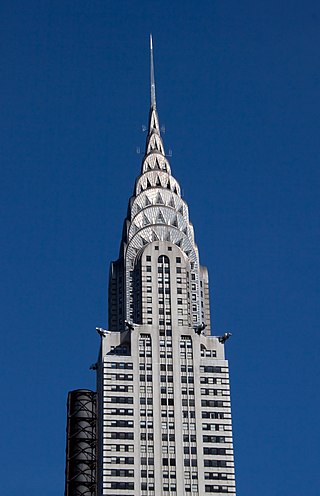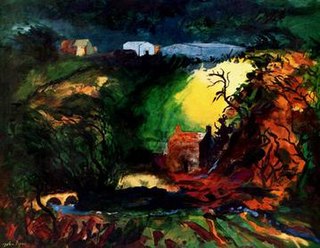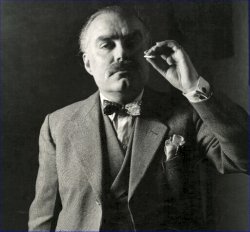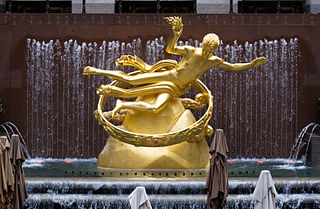
Art Deco, short for the French Arts décoratifs, is a style of visual arts, architecture, and product design, that first appeared in Paris in the 1910s, and flourished in the United States and Europe during the 1920s to early 1930s. Through styling and design of the exterior and interior of anything from large structures to small objects, including how people look, Art Deco has influenced bridges, buildings, ships, ocean liners, trains, cars, trucks, buses, furniture, and everyday objects including radios and vacuum cleaners.

Sir John Betjeman, was an English poet, writer, and broadcaster. He was Poet Laureate from 1972 until his death. He was a founding member of The Victorian Society and a passionate defender of Victorian architecture, helping to save St Pancras railway station from demolition. He began his career as a journalist and ended it as one of the most popular British Poets Laureate and a much-loved figure on British television.

John Egerton Christmas Piper CH was an English painter, printmaker and designer of stained-glass windows and both opera and theatre sets. His work often focused on the British landscape, especially churches and monuments, and included tapestry designs, book jackets, screen prints, photography, fabrics and ceramics. He was educated at Epsom College and trained at the Richmond School of Art followed by the Royal College of Art in London. He turned from abstraction early in his career, concentrating on a more naturalistic but distinctive approach, but often worked in several different styles throughout his career.

Edwin Emmanuel Bradford was an English clergyman and a Uranian poet and writer of stories, articles and sermons. His prolific verse celebrating the high spiritual status of love between men and boys was remarkably well-received and favourably reviewed in his lifetime.

Andrew Norman Wilson is an English writer and newspaper columnist known for his critical biographies, novels and works of popular history. He is an occasional columnist for the Daily Mail and a former columnist for the London Evening Standard. He has been an occasional contributor to The Times Literary Supplement, New Statesman, The Spectator and The Observer.
Barry Zaid is a graphic artist and designer.

David William Gentleman is an English artist. He studied art and painting at the Royal College of Art under Edward Bawden and John Nash. He has worked in watercolour, lithography and wood engraving, at scales ranging from platform-length murals for Charing Cross Underground Station in London to postage stamps and logos.

Sir Osbert Lancaster was an English cartoonist, architectural historian, stage designer and author. He was known for his cartoons in the British press, and for his lifelong work to inform the general public about good buildings and architectural heritage.

Futurist architecture is an early-20th century form of architecture born in Italy, characterized by long dynamic lines, suggesting speed, motion, urgency and lyricism: it was a part of Futurism, an artistic movement founded by the poet Filippo Tommaso Marinetti, who produced its first manifesto, the Manifesto of Futurism, in 1909. The movement attracted not only poets, musicians, and artists but also a number of architects. A cult of the Machine Age and even a glorification of war and violence were among the themes of the Futurists - several prominent futurists were killed after volunteering to fight in World War I. The latter group included the architect Antonio Sant'Elia, who, though building little, translated the futurist vision into an urban form.

Russell Ash was the British author of the Top 10 of Everything series of books, as well as Great Wonders of the World, Incredible Comparisons and many other reference, art and humour titles, most notably his series of books on strange-but-true names, Potty, Fartwell & Knob, Busty, Slag and Nob End and Big Pants, Burpy and Bumface. Once described as 'the human Google', his obituary in The Times stated that 'In the age of the internet, it takes tenacity and idiosyncratic intelligence to make a living from purveying trivial information. Russell Ash did just that'.
Honor Tracy was a British writer of novels and travel literature.
Samuel Elsworth Cottam was an English poet and Anglican priest.

Sir John Betjeman (1906–1984) was a twentieth-century English poet, writer and broadcaster. Born to a middle-class family in Edwardian Hampstead, he attended Oxford University, although left without graduating. He turned down a position in the family furniture business, and instead took a series of jobs before becoming the assistant editor of The Architectural Review in 1931, which reflected a deeply held affection for buildings and their history. That same year he published his first book, Mount Zion, a collection of poems.

Howard Martin Otho Travers was an English church artist and designer.

The Surfcomber Hotel is a boutique hotel on Collins Avenue in the historic Art Deco district of South Beach in Miami Beach, Florida. The hotel was built in 1948 and was acquired by the Kimpton hotel chain in April 2011. The Surfcomber is known for pool parties, and it served as the headquarters for MTV during the 2005 MTV Video Music Awards and for Bud Light during Super Bowl XLIV in 2010. The hotel is located at 1717 Collins Avenue, on the shore of Miami's South Beach.

The Narcissus washstand is a piece of painted furniture made by the Victorian architect and designer William Burges in 1867. It was originally made for Burges's set of rooms at Buckingham Street and subsequently moved to his bedroom at The Tower House, the house he designed for himself in Holland Park in London. John Betjeman, later Poet Laureate and a leading champion of the art and architecture of the Victorian Gothic Revival, was left the remaining lease on the Tower House, including some of the furniture, by E. R. B. Graham in 1961. He gave the washstand, which he found in a second-hand shop in Lincoln, to the novelist Evelyn Waugh who featured it in his 1957 novel, The Ordeal of Gilbert Pinfold, mirroring a real-life incident when Waugh, in the grip of bromide poisoning, became convinced that an ornamental tap was missing from the washstand.

Theyre Lee-Elliott was an English artist who created notable Art Deco logos such as the Speedbird and painted the ballet and religious art.

Art Deco of the 20s and 30s is an art history book by English historian Bevis Hillier. It was initially published in 1968 by Studio Vista. The author discusses how the style of cubism, expressionism, Ancient Egyptian art, Mayan art, and so on influenced Art Deco, and how Art Deco itself changed the style of disciplines as various as modern architecture, jewelry, ceramics, tableware, metalwork, glass, textiles, and many others.

The Art Deco style, which originated in France just before World War I, had an important impact on architecture and design in the United States in the 1920s and 1930s. The most notable examples are the skyscrapers of New York City, including the Empire State Building, Chrysler Building, and Rockefeller Center. It combined modern aesthetics, fine craftsmanship, and expensive materials, and became the symbol of luxury and modernity. While rarely used in residences, it was frequently used for office buildings, government buildings, train stations, movie theaters, diners and department stores. It also was frequently used in furniture, and in the design of automobiles, ocean liners, and everyday objects such as toasters and radio sets.

La Maison Cubiste, also called Projet d'hôtel, was an architectural installation in the Art Décoratif section of the 1912 Paris Salon d'Automne which presented a Cubist vision of architecture and design. Critics and collectors present at the exhibition were confronted for the first time with the prospect of a Cubist architecture.















